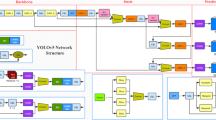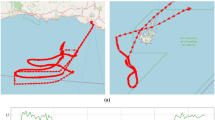Abstract
The unmonitored jellyfish boom inevitably destroys coastal biodiversities as a type of planktons with extremely high fecundity. It even seriously endangers people’s economic and social activities, such as clogging the water intake system of hydropower plants and hindering coastal tourism development. In the past, underwater video monitoring tended to be time-consuming and costly. This paper proposes JF-YOLO: an automatic jellyfish blooms detection model based on deep learning. We collecte many jellyfish videos in real environments to form a dataset for model training. JF-YOLO uses the improved YOLO-V4 detection model to ensure detection accuracy and speed. The experimental results show that the detection accuracy of the JF-YOLO network is better than that of the YOLO-V4 network, with the average detection accuracy increasing from 85.35% to 92.67% and the recall rate increasing from 72.32% to 85.74%. As a promising solution, JF-YOLO can effectively monitor the number or density of jellyfish and provide early warning when they appear abnormal, bringing convenience to ocean governance.













Similar content being viewed by others
Data Availability
The datasets generated during the current study are not publicly available due Additional research required but are available from the corresponding author on reasonable request.
References
Ambati LS, El-Gayar O (2021) Human activity recognition: a comparison of machine learning approaches. J Midwest Assoc Inform Syst (JMWAIS) 2021:1. https://doi.org/10.17705/3jmwa.000065
An L, Wang L, Ou D, Jia C, Li W, Ding Y, You C, Liao J, Huang H (2021) The ecological mechanisms of Acetes blooms as a threat to the security of cooling systems in coastal nuclear power plants. J Coast Conserv 25 (6):1–10
Baliarsingh S K, Lotliker A A, Srichandan S, Samanta A, Kumar N, Nair TM B (2020) A review of jellyfish aggregations, focusing on India’s coastal waters. Ecol Process 9(1):1–9
Barrado C, Fuentes J A, Salamí E, Royo P, Olariaga A D, López J, Fuentes V L, Gili J M, Pastor E (2014) Jellyfish monitoring on coastlines using remote piloted aircraft. In: IOP conference series: Earth and environmental science, vol 17. IOP Publishing, p 012195
Bochkovskiy A, Wang C-Y, Liao H-Y M (2020) Yolov4: optimal speed and accuracy of object detection. arXiv:2004.10934
Bosch-Belmar M, Milisenda G, Basso L, Doyle T K, Leone A, Piraino S (2020) Jellyfish impacts on marine aquaculture and fisheries. Rev Fisheries Sci Aquacult 29(2):242–259
Chen Q, Wang Y, Yang T, Zhang X, Cheng J, Sun J (2021) You only look one-level feature. In: Proceedings of the IEEE/CVF conference on computer vision and pattern recognition, pp 13039–13048
El-Gayar O F, Ambati L S, Nawar N (2020) Wearables, artificial intelligence, and the future of healthcare. IGI Global. https://www.igi-global.com/chapter/wearables-artificial-intelligence-and-the-future-of-healthcare/www.igi-global.com/chapter/wearables-artificial-intelligence-and-the-future-of-healthcare/236337
Ghermandi A, Galil B, Gowdy J, Nunes PALD (2015) Jellyfish outbreak impacts on recreation in the Mediterranean Sea: Welfare estimates from a socioeconomic pilot survey in Israel. Ecosyst Serv 11 :140–147
Girshick R, Donahue J, Darrell T, Malik J (2014) Rich feature hierarchies for accurate object detection and semantic segmentation. In: Proceedings of the IEEE conference on computer vision and pattern recognition, pp 580–587
Goutte C, Gaussier E (2005) A probabilistic interpretation of precision, recall and F-score, with implication for evaluation. In: European conference on information retrieval. Springer, pp 345–359
Graham W M, Martin D L, Martin J C (2003) In situ quantification and analysis of large jellyfish using a novel video profiler. Mar Ecol Prog Ser 254:129–140. https://doi.org/10.3354/meps254129
Han Y, Chang Q, Ding S, Gao M, Zhang B, Li S (2022) Research on multiple jellyfish classification and detection based on deep learning. Multimed Tools Applic 81(14):19429–19444. https://doi.org/10.1007/s11042-021-11307-y
He K, Zhang X, Ren S, Sun J (2016) Deep residual learning for image recognition. In: Proceedings of the IEEE conference on computer vision and pattern recognition, pp 770–778
Influence of the digital divide and socio-economic factors on prevalence of diabetes. Issues In Information Systems (2020) https://doi.org/10.48009/4_iis_2020_103-113
Kamili A, Fatima I, Hassan M, Parah S A, Vijaya Kumar V, Ambati L S (2020) Embedding information reversibly in medical images for e-health. J Intell Fuzzy Syst 39(6):8389–8398. https://doi.org/10.3233/JIFS-189157
Kim D, Shin J-, Kim H, Lee D, Lee S-M, Myung H (2013) Experimental tests of autonomous jellyfish removal robot system JEROS. In: Kim J-H, Matson E T, Myung H, Xu P (eds) Robot intelligence technology and applications 2012, vol 208. Springer, Berlin, pp 395–403. https://doi.org/10.1007/978-3-642-37374-9_38
Kim D, Kim H, Jung S, Koo J, Kim J, Myung H (2015) A vision-based detection algorithm for moving jellyfish in underwater environment. In: 2015 12th International conference on ubiquitous robots and ambient intelligence (URAI). IEEE, pp 144–145
Kim H, Kim D, Jung S, Koo J, Shin J-U, Myung H (2015) Development of a UAV-type jellyfish monitoring system using deep learning. In: 2015 12th International conference on ubiquitous robots and ambient intelligence (URAI). IEEE, Goyang, pp 495–497. https://doi.org/10.1109/URAI.2015.7358813
Kim H, Koo J, Kim D, Jung S, Shin J-U, Lee S, Myung H (2016) Image-based monitoring of jellyfish using deep learning architecture. IEEE Sens J 16(8):2215–2216. https://doi.org/10.1109/JSEN.2016.2517823
Labao A B, Naval P C Jr (2019) Cascaded deep network systems with linked ensemble components for underwater fish detection in the wild. Eco Inform 52:103–121
LeCun Y, Bengio Y, Hinton G (2015) Deep learning. Nature 521(7553):436–444
Li J, Su Z, Geng J, Yin Y (2018) Real-time detection of steel strip surface defects based on improved yolo detection network. IFAC-PapersOnLine 51(21):76–81
Liang T, Chu X, Liu Y, Wang Y, Tang Z, Chu W, Chen J, Ling H (2021) Cbnetv2: a composite backbone network architecture for object detection. arXiv:2107.00420
Lin T-Y, Dollár P, Girshick R, He K, Hariharan B, Belongie S (2017) Feature pyramid networks for object detection. In: Proceedings of the IEEE conference on computer vision and pattern recognition, pp 2117–2125
Liu J, Yu C, Hu Z, Zhao Y, Bai Y, Xie M, Luo J (2020) Accurate prediction scheme of water quality in smart mariculture with deep Bi-S-SRU learning network. IEEE Access: Practical Innovations, Open Solutions 8:24784–24798
Liu W, Anguelov D, Erhan D, Szegedy C, Reed S, Fu C-Y, Berg A C (2016) Ssd: single shot multibox detector. In: European conference on computer vision. Springer, pp 21–37
Liu Y, Wang Y, Wang S, Liang T, Zhao Q, Tang Z, Ling H (2020) Cbnet: a novel composite backbone network architecture for object detection. In: Proceedings of the AAAI conference on artificial intelligence, vol 34, pp 11653–11660
Martin-Abadal M, Ruiz-Frau A, Hinz H, Gonzalez-Cid Y (2020) Jellytoring: real-time jellyfish monitoring based on deep learning object detection. Sensors 20(6):1708. https://doi.org/10.3390/s20061708
Mcilwaine B, Rivas Casado M (2021) JellyNet: the convolutional neural network jellyfish bloom detector. Int J Appl Earth Obs Geoinf 97:102279. https://doi.org/10.1016/j.jag.2020.102279
Misra D (2019) Mish: a self regularized non-monotonic activation function. arXiv:1908.08681
Miyao Y, Isobe A, et al. (2014) An application of low-altitude remote sensing using a vessel-towed balloon for monitoring jellyfish patchiness in coastal waters. J Remote Sens Soc Jpn 34(2):113–120
Peng F, Miao Z, Li F, Li Z (2021) S-FPN: a shortcut feature pyramid network for sea cucumber detection in underwater images. Expert Syst Appl, 115306
Pierce J (2009) Prediction, location, collection and transport of jellyfish (Cnidaria) and their polyps. Zoo Biol 28(2):163–176. https://doi.org/10.1002/zoo.20218
Redmon J, Farhadi A (2018) Yolov3: an incremental improvement. arXiv:1804.02767
Ren S, He K, Girshick R, Sun J (2015) Faster r-cnn: towards real-time object detection with region proposal networks. Adv Neural Inform Process Syst 28:91–99
Rife J, Rock SM (2003) Segmentation methods for visual tracking of deep-ocean jellyfish using a conventional camera. IEEE J Oceanic Eng 28(4):595–608. https://doi.org/10.1109/JOE.2003.819315
Roohi A, Kideys A E, Sajjadi A, Hashemian A, Pourgholam R, Fazli H, Khanari A G, Eker-Develi E (2010) Changes in biodiversity of phytoplankton, zooplankton, fishes and macrobenthos in the Southern Caspian Sea after the invasion of the ctenophore Mnemiopsis leidyi. Biol Invasions 12(7):2343–2361
Samsuri SS, Arshad MR, AManaf A, Yaacob MIH (2017) Detection of jellyfish using acoustic sensor. Methods (San Diego, Calif.) 10:0–0049
Tian Y, Yang G, Wang Z, Wang H, Li E, Liang Z (2019) Apple detection during different growth stages in orchards using the improved YOLO-V3 model. Comput Electron Agricul 157:417–426
Wang C-Y, Liao H-Y M, Wu Y-H, Chen P-Y, Hsieh J-W, Yeh I-H (2020) CSPNet: a new backbone that can enhance learning capability of CNN. In: Proceedings of the IEEE/CVF conference on computer vision and pattern recognition workshops, pp 390–391
Wang K, Liew J H, Zou Y, Zhou D, Feng J (2019) Panet: few-shot image semantic segmentation with prototype alignment. In: Proceedings of the IEEE/CVF international conference on computer vision, pp 9197–9206
Woo S, Park J, Lee J-Y, Kweon I S (2018) Cbam: convolutional block attention module. In: Proceedings of the European conference on computer vision (ECCV), pp 3–19
Xiufen Wang, Huiyuan Wang, Song Wang (2011) Jellyfish detection based on K-FOE residual map and ring segmentation. In: 2011 IEEE 13th international conference on communication technology. IEEE, Jinan, pp 762–766. https://doi.org/10.1109/ICCT.2011.6157979
Yi Z, Yongliang S, Jun Z (2019) An improved tiny-yolov3 pedestrian detection algorithm. Optik 183 :17–23
Zhang J, Zhang X (2019) Automatic recognition and counting method of deep-sea jellyfish based on image multi-feature matching. In: 2019 11th International conference on intelligent human-machine systems and cybernetics (IHMSC), vol 1. IEEE, pp 233–236
Zheng Z, Wang P, Liu W, Li J, Ye R, Ren D (2020) Distance-IoU loss: faster and better learning for bounding box regression. In: Proceedings of the AAAI conference on artificial intelligence, vol 34, pp 12993–13000
Zi W, Yong T, Yuanyuan F, Wei M, Shuai W, Xiaolin L (2020) Monitoring of biomass at cooling water system of hongyanhe nuclear power plant by using acoustic methods. In: E3S web of conferences, vol 194. EDP Sciences, p 01007
Acknowledgments
This work was supported in part by the Natural Science Foundation of Hebei Province, Research on 3D dense reconstruction of underwater vision based on deep learning and point cloud quadratic determination (Grant numbers F2019203195) and National Natural Science Foundation of China, Research on occlusion perception, repair and reliability evaluation method for occlusion face recognition (Grant numbers 62106214).
Author information
Authors and Affiliations
Corresponding author
Ethics declarations
Competing interests
The authors declare that they have no known competing financial interests or personal relationships that could have appeared to influence the work reported in this paper.
Additional information
Publisher’s note
Springer Nature remains neutral with regard to jurisdictional claims in published maps and institutional affiliations.
Rights and permissions
Springer Nature or its licensor (e.g. a society or other partner) holds exclusive rights to this article under a publishing agreement with the author(s) or other rightsholder(s); author self-archiving of the accepted manuscript version of this article is solely governed by the terms of such publishing agreement and applicable law.
About this article
Cite this article
Zhang, W., Rui, F., Xiao, C. et al. JF-YOLO: the jellyfish bloom detector based on deep learning. Multimed Tools Appl 83, 7097–7117 (2024). https://doi.org/10.1007/s11042-023-15465-z
Received:
Revised:
Accepted:
Published:
Issue Date:
DOI: https://doi.org/10.1007/s11042-023-15465-z




